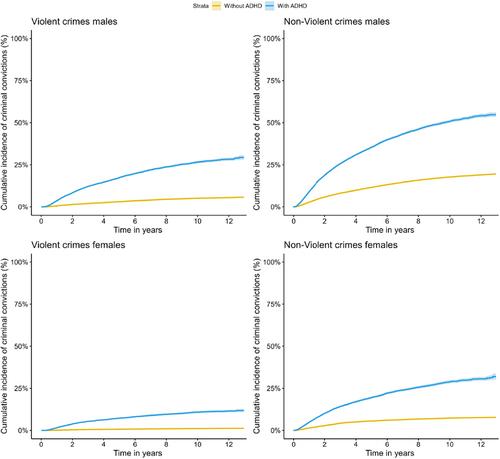Criminal convictions in males and females diagnosed with attention deficit hyperactivity disorder: A Swedish national registry study
Abstract
Background
Individuals with Attention-Deficit/Hyperactivity Disorder (ADHD) face an elevated risk of criminal convictions compared to those without ADHD. However, understanding this link involves considering sex differences, coexisting psychiatric conditions, and unmeasured familial factors. This study aimed to explore the connection between ADHD and criminal convictions (both violent and non-violent) in males and females, while also assessing the impact of comorbid psychiatric disorders and familial factors.
Methods
Using Swedish national registers, we identified individuals born between 1986 and 1997 (635,391 males and 600,548 females). ADHD was defined through clinical diagnosis and prescribed medications, while criminal convictions were determined based on Swedish lower court records. Unmeasured familial factors were accounted for using a sibling design approach.
Results
Findings revealed that individuals with ADHD had a notably higher absolute and relative risk of both violent and non-violent criminal convictions compared to those without ADHD. While criminal convictions were more frequent among males with ADHD, females with ADHD exhibited higher relative risks (HR violent 10.50, non-violent 4.04) than their male counterparts (HR violent 6.03, non-violent 3.57). Additionally, lower socioeconomic status (SES) in individuals with ADHD was associated with increased relative risks for criminal convictions compared to individuals with ADHD who had higher SES. Adjusting for childhood and internalizing psychiatric disorders partially attenuated these associations, while substance use disorders (SUD) substantially attenuated them. SUD also contributed to an elevated absolute risk of criminal convictions in both male and female individuals with ADHD. Accounting for unmeasured shared familial factors slightly reduced the estimates, but the association between ADHD and criminal convictions persisted.
Conclusion
In conclusion, ADHD remains a potent independent risk factor for criminal convictions, with varying effects based on gender. This underscores the importance of tailored crime prevention strategies and early interventions for individuals with ADHD, especially when comorbid SUD is present.



 求助内容:
求助内容: 应助结果提醒方式:
应助结果提醒方式:


